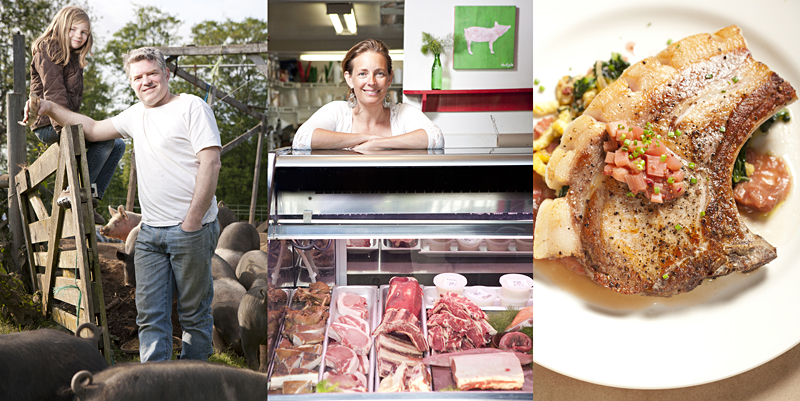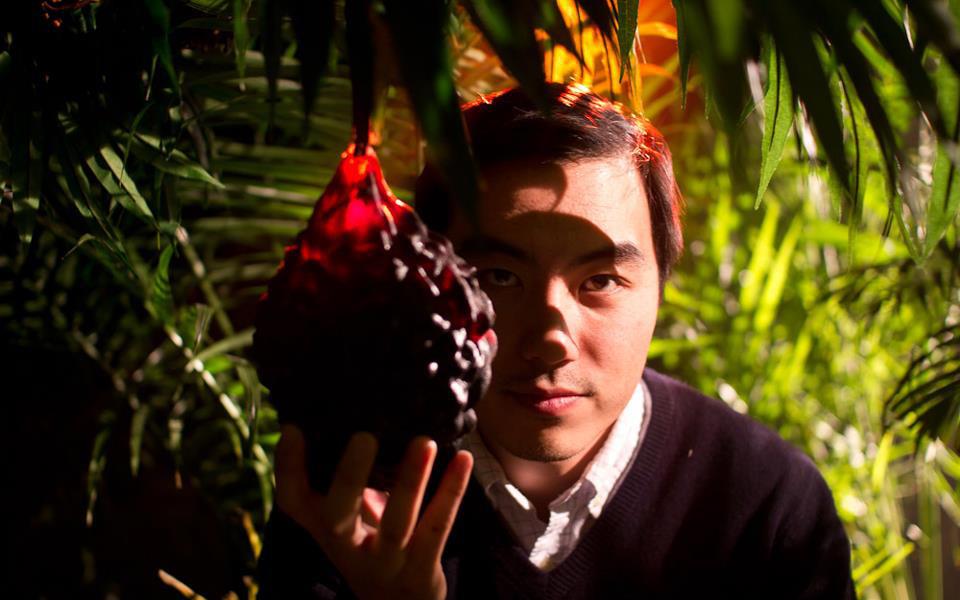Somewhere there must be a chef and farmer who’ve agreed to keep their working relationship relatively discreet, but the vast majority of liaisons in the locavore era are kiss-and-tell affairs. Once a restaurant hooks up with a grower, his or her name is splashed on every available surface: In the grand tradition of tree-trunk carvings and bathroom graffiti, the farm/fork romance is enshrined in press releases, appended to menus, scribbled on websites, and emblazoned on walls. And lest any customer dare question the depth of the restaurant’s affections, servers are primed to spill all the juicy details—”Would you like to hear about the time our sous-chef helped the farmer dismember her chickens?”
There’s none of that showboating at La Boucherie, however. The rare restaurant which actually would be entitled to brag on its sourcing, La Boucherie is the in-town extension of Vashon Island’s Sea Breeze Farm, where Travel Channel personality Andrew Zimmern last year snacked on bovine placenta and slurped cow colostrum. Among Seattle eaters, Sea Breeze is probably better known for its meat, milk, and cheese, which it sells at the U District and Ballard farmers markets. Those items form the core of the menu at La Boucherie, but the only signal to diners that all the meat is homegrown is a butcher case in the restaurant’s front room and a sketch of a curly-tailed hog on its bookmark-sized menu. Otherwise, owners George and Kristin Page are content to let their extraordinary pork squeal for itself.
“We can only make it so clear,” Sea Breeze butcher Lauren Garaventa says. “If you push certain things, it can be a little bit alienating, and we definitely don’t want to do that.”
Since the restaurant’s mission isn’t promiscuously advertised, diners are sometimes slow to intuit that every animal on the menu shares an alma mater. “A lot of people ask for fish,” Garaventa says. Their confusion is compounded by the restaurant’s distance from Sea Breeze: When the Pages four years ago wanted an additional outlet for their products, they opened La Boucherie in a former fish market that got its start as a malt shop. They toyed with the idea of building a restaurant on their farm, four miles north, but, as Garaventa points out, a chicken, cow, sheep, and pig farm is a considerably less pleasant place than one which specializes in miner’s lettuce and lavender. “It’s a muddy, dirty situation,” she says.
With a span of worn-down asphalt outside the restaurant and an unfashionable amount of modesty within it, the trustiest way of knowing that 95 percent of La Boucherie’s ingredients originate on Vashon is to eat there, which you really ought to do just as soon as you can get a reservation. Garaventa and chef Dustin Calery, who grew up on a Kentucky farm, are masterfully translating the island’s bounty into dishes that rival any served in Seattle for visceral deliciousness.
On the list of farmers’ favorites things, fussiness rates about as high as hailstorms, and La Boucherie’s ever-changing menu is free of highfalutin airs. A recent evening’s amuse-bouche consisted of a juicy chiogga beet pellet wigged with a cloud of wickedly spongy ricotta cheese and a split hazelnut. The stem of a single kite-shaped leaf was wedged beneath the beet, making the tiny tripartite bite look very much like a lonely sloop adrift on a white supper plate. But the kitchen tempers its plainspoken streak with an aestheticism that results in such essential trifles as the sparkling rhubarb wine served alongside its welcome-mat snack.
Calery is willing to work in pink. In addition to the beets and wine, he serves a salad of apples with skins the shade of little-girl lipstick. The slivered fruit is drizzled with a honey vinaigrette that’s beckoned back from oversweetness by a sprinkling of black pepper. Here too are toasted hazelnuts and ricotta cheese, since a farm restaurant isn’t wont to waste. With ingredients this magnificent, though, syndication isn’t a problem.
Simplicity and frugality aren’t the only values fresh from the farm. The tables in the compact dining room aren’t so much arranged as herded, jammed in by someone accustomed to driving stubborn beasts into a barn. When I visited La Boucherie, I was seated at a brown linen-draped table shoved into a back corner, with one seat facing a window overlooking the parking lot and the other facing a wall. Oddly, though, the restaurant’s pragmatic approach to interior design makes for a very romantic room. Cognizant of the proximity of other guests, diners here tend to speak softly. And candles are everywhere, if only because the Vashon-grown flowers that serve as summer centerpieces haven’t blossomed yet.
The bohemian charms of the room, its walls hung with vintage black-and-white photographs of carousing Serbian gypsies, might not square with some diners’ notions of the proper setting for a $99 six-course meal with wine pairings. And a few weaknesses are exposed when the restaurant messes with edibles that would be better left to practiced Europeans: The pasta, made with Washington wheat, is gummy and damp, and a cloudy semillon from Sea Breeze’s winery was awful.
Yet the rigatoni’s problems are easily overcome by an earthy Bolognese made with ground pork. Not every outstanding dish at La Boucherie includes pork; a frothy cauliflower soup garnished with shreds of chicken confit is a rich, flavorful romp, and a pile of blanched leeks topped by a fried egg has a bucolic vitality that can’t be faked. But the dishes that will linger on your palate as you ride the ferry home, and on your mind as you eat in lesser restaurants, are the ones made with pig flesh.
Garaventa makes rilletes, terrines, and pâtés from scraps of Sea Breeze sausages which don’t sell at market. The best selections on the charcuterie plate are the most jumbled and rustic preparations, such as the pâté de campagne, a deft meeting of velvety fat and skill.
La Boucherie cuts its exceedingly great pork chops from the blade end of the loin, picking up lots of luscious shoulder fat. But where Garaventa puts her cleaver may not matter as much as where Sea Breeze puts its pigs: The farm’s Duroc-Berkshires spend their lives roaming a patch of Vashon blanketed with blackberry bushes. They return to the farm to spend the month before slaughter feasting on discards from Sea Breeze’s dairy. “Raising pigs outside is why pigs taste good,” Garaventa says.
Since the pigs’ foraged diets change according to the seasons, Sea Breeze’s pork doesn’t taste the same in January as in June. Because the pigs are now eating lots of just-sprouted greens, their meat is marbled with extra-creamy fat.
“It’s a good time to eat pork,” Garaventa says. And although she’s too polite to say so, La Boucherie is a very good place in which to eat it.
Price Guide
Charcuterie $9/$15
Apple salad $10
Bolognese $23
Pork chop $26
Tasting menu $69








